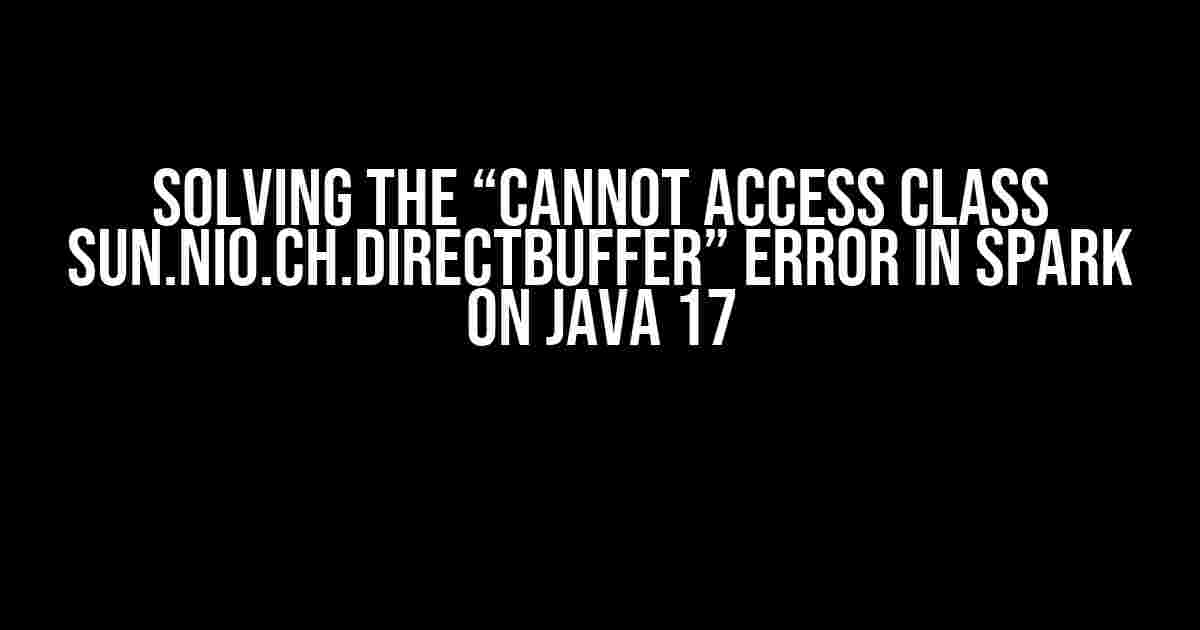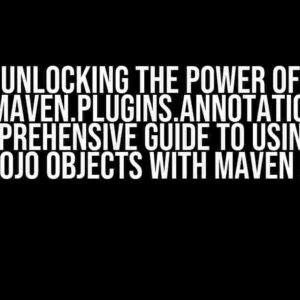Are you trying to run Spark on Java 17 and continuously running into the “Cannot Access Class sun.nio.ch.DirectBuffer” error? Well, you’re not alone! This error has been plaguing Spark developers for a while now, and it’s about time someone shed some light on the solution.
What’s Causing the Error?
Before we dive into the solution, let’s understand what’s causing this error in the first place. The “Cannot Access Class sun.nio.ch.DirectBuffer” error is a result of the Java 17’s strict access control mechanism. In Java 17, the `sun.nio.ch.DirectBuffer` class has been moved to the `jdk.unsupported` module, which is not accessible by default.
Spark, being a Java-based framework, relies heavily on the `sun.nio.ch.DirectBuffer` class to manage its memory and buffer operations. However, with Java 17’s new access control mechanism, Spark is no longer able to access this class, resulting in the dreaded “Cannot Access Class sun.nio.ch.DirectBuffer” error.
Solution 1: Add the `–add-exports` Flag
One way to solve this error is by adding the `–add-exports` flag to your Spark configuration. This flag allows you to export the `sun.nio.ch.DirectBuffer` class to the Spark module, granting access to the necessary resources.
spark-submit --class org.apache.spark.example.SparkApp --add-exports java.base/jdk.internal.ref=ALL-UNNAMED --add-exports java.base/sun.nio.ch=ALL-UNNAMED --add-exports jdk.unsupported/sun.nio.ch=ALL-UNNAMED your-spark-app.jar [your-app-arguments]
In the above code snippet, we’re adding three `–add-exports` flags to our `spark-submit` command. These flags export the necessary classes to the Spark module, allowing it to access the `sun.nio.ch.DirectBuffer` class.
Solution 2: Use the `–add-opens` Flag
Another way to solve this error is by using the `–add-opens` flag. This flag allows you to open the `sun.nio.ch.DirectBuffer` class to the Spark module, granting access to the necessary resources.
spark-submit --class org.apache.spark.example.SparkApp --add-opens java.base/jdk.internal.ref=org.apache.spark --add-opens java.base/sun.nio.ch=org.apache.spark --add-opens jdk.unsupported/sun.nio.ch=org.apache.spark your-spark-app.jar [your-app-arguments]
In the above code snippet, we’re adding three `–add-opens` flags to our `spark-submit` command. These flags open the necessary classes to the Spark module, allowing it to access the `sun.nio.ch.DirectBuffer` class.
Solution 3: Modify Your `spark-defaults.conf` File
If you’re tired of adding flags to your `spark-submit` command every time, you can modify your `spark-defaults.conf` file to include the necessary configurations.
Create a file named `spark-defaults.conf` in your Spark configuration directory (usually `SPARK_HOME/conf/`) and add the following lines:
spark.driver.extraJavaOptions -Xmx1024m -Djava.library.path=/usr/local/lib --add-exports java.base/jdk.internal.ref=ALL-UNNAMED --add-exports java.base/sun.nio.ch=ALL-UNNAMED --add-exports jdk.unsupported/sun.nio.ch=ALL-UNNAMED spark.executor.extraJavaOptions -Xmx1024m -Djava.library.path=/usr/local/lib --add-exports java.base/jdk.internal.ref=ALL-UNNAMED --add-exports java.base/sun.nio.ch=ALL-UNNAMED --add-exports jdk.unsupported/sun.nio.ch=ALL-UNNAMED
This will add the necessary configurations to your Spark driver and executor, allowing them to access the `sun.nio.ch.DirectBuffer` class.
Conclusion
In this article, we’ve explored three solutions to the “Cannot Access Class sun.nio.ch.DirectBuffer” error in Spark on Java 17. Whether you choose to add flags to your `spark-submit` command, use the `–add-opens` flag, or modify your `spark-defaults.conf` file, you should now be able to run Spark on Java 17 without any issues.
Remember, the key to solving this error is to grant Spark access to the `sun.nio.ch.DirectBuffer` class, which is restricted in Java 17. By using one of the above solutions, you’ll be able to overcome this error and get back to building awesome Spark applications!
Frequently Asked Questions
Q: What’s the difference between the `–add-exports` and `–add-opens` flags?
A: The `–add-exports` flag exports the specified class to the specified module, while the `–add-opens` flag opens the specified class to the specified module. In our case, both flags achieve the same result, but `–add-opens` is a more flexible and powerful option.
Q: Can I use these solutions with Spark 2.x or Spark 3.x?
A: Yes, these solutions should work with Spark 2.x and Spark 3.x, as long as you’re running Java 17. However, keep in mind that Spark 3.x has better support for Java 17, so you might not need these workarounds.
Q: What if I’m using a different Java version?
A: These solutions are specific to Java 17. If you’re using a different Java version, you might not encounter this error. However, if you do, you can try using the `–add-exports` or `–add-opens` flags to see if they resolve the issue.
| Solution | Description |
|---|---|
| –add-exports Flag | Exports the specified class to the specified module. |
| –add-opens Flag | Opens the specified class to the specified module. |
| spark-defaults.conf | Modifies the Spark configuration file to include the necessary flags. |
This table summarizes the three solutions discussed in this article. Choose the one that works best for your use case!
This article has provided a comprehensive guide to solving the “Cannot Access Class sun.nio.ch.DirectBuffer” error in Spark on Java 17. With these solutions, you should now be able to run Spark on Java 17 without any issues. Happy Sparking!
Frequently Asked Question
Are you tired of encountering the “cannot access class sun.nio.ch.DirectBuffer” error while using Spark on Java 17? Worry no more! Below are some frequently asked questions and answers to help you troubleshoot and resolve this issue.
Q1: What is the main reason behind the “cannot access class sun.nio.ch.DirectBuffer” error in Spark on Java 17?
The primary reason for this error is that Java 17 has removed the ‘sun.nio.ch.DirectBuffer’ class, which is used by Spark for its internal operations. As a result, Spark is unable to access this class, leading to the error.
Q2: Is there a way to use Spark with Java 17 without encountering this error?
Yes, you can use Spark with Java 17 by adding the ‘–add-exports java.base/sun.nio.ch=ALL-UNNAMED’ flag to your Java command. This flag allows Spark to access the ‘sun.nio.ch.DirectBuffer’ class, resolving the error.
Q3: Can I use Spark 3.x with Java 17 to avoid this error?
Yes, Spark 3.x is compatible with Java 17 and does not use the ‘sun.nio.ch.DirectBuffer’ class. Upgrading to Spark 3.x can be a viable solution to avoid this error.
Q4: How can I check the Java version used by Spark?
You can check the Java version used by Spark by running the command ‘spark-shell –version’ or ‘spark-submit –version’ in your terminal. This will display the Java version used by Spark.
Q5: Are there any other alternatives to resolve the “cannot access class sun.nio.ch.DirectBuffer” error?
Yes, you can also use the ‘–add-opens java.base/sun.nio.ch=ALL-UNNAMED’ flag instead of ‘–add-exports’. Additionally, you can downgrade to Java 11 or lower, which still supports the ‘sun.nio.ch.DirectBuffer’ class. However, using Spark 3.x or adding the ‘–add-exports’ flag is a more recommended solution.
There you have it! By following these FAQs, you should be able to troubleshoot and resolve the “cannot access class sun.nio.ch.DirectBuffer” error while using Spark on Java 17.


